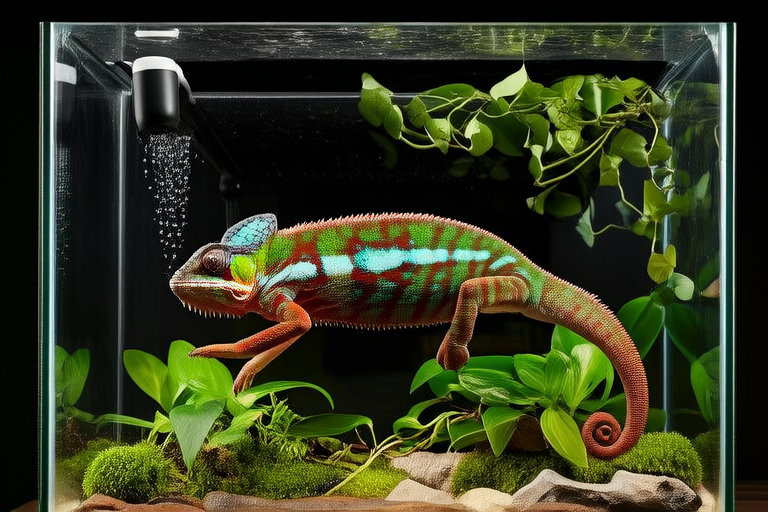From Jungle to Home: How to Set Up the Perfect Habitat for Your Chameleon
Welcome to the fascinating world of chameleons! These unique reptiles, known for their vibrant color changes and prehensile tails, are becoming increasingly popular pets among reptile enthusiasts. However, caring for a chameleon requires more than just love; it demands understanding their specific needs to create a safe, stress-free environment that closely mimics their natural jungle habitat. This guide will walk you through setting up the perfect habitat for your chameleon, covering everything from tank size and lighting requirements to diet specifics and regular maintenance tips.
Choosing the Right Tank Size
The first step in creating an ideal habitat is selecting an appropriately sized enclosure. A chameleon’s tank should be spacious enough to allow them ample room to move around and climb. For juvenile chameleons, a 20-gallon tank can suffice, but adults require larger enclosures—typically between 40 to 75 gallons. The height of the tank is especially crucial, as chameleons are arboreal creatures and prefer vertical space over horizontal. Ensure that the tank has plenty of branches and foliage at various heights so your pet can explore its environment comfortably.
Lighting Requirements: UVB Lighting
Chameleons rely heavily on ultraviolet B (UVB) light for synthesizing vitamin D3, which aids in calcium absorption necessary for healthy bone development. Without adequate exposure to UVB rays, they may suffer from metabolic bone disease (MBD). Therefore, investing in high-quality UVB bulbs is non-negotiable. Place the UVB bulb at one end of the tank to create a gradient where your chameleon can bask under direct light or retreat into shaded areas when needed. Replace the bulb every six months, even if it still appears functional, since UV output diminishes over time.
Temperature Gradients
Maintaining optimal temperatures within the enclosure is vital for your chameleon’s health. Chameleons are ectothermic animals, meaning they regulate their body temperature by absorbing heat from external sources. Aim for a basking spot temperature ranging from 85°F to 95°F (29°C to 35°C) at the warmest point of the tank. Cooler areas should range between 75°F and 85°F (24°C to 29°C). Use thermometers placed both near the top and bottom of the tank to monitor these gradients accurately. Avoid placing the tank near windows where direct sunlight might cause overheating or drafts could lead to cold spots.
Humidity Levels
Chameleons thrive in humid environments, typically requiring humidity levels between 50% and 70%. Achieving this level involves regular misting of the enclosure with distilled water twice daily. Automated misting systems are available for those who find manual misting inconvenient. Additionally, consider installing a drip system or fogger to maintain consistent moisture throughout the day. Monitor humidity levels using hygrometers strategically positioned inside the tank.
Substrate Options
Choosing the right substrate is essential for preventing ingestion hazards and maintaining hygiene. While some substrates like sand or gravel can pose choking risks, certain alternatives work well. Paper towels or newspaper are excellent choices for easy cleaning and minimal risk. Alternatively, coconut fiber or bark chips can add aesthetics while being safe for your chameleon. Regardless of what you choose, ensure thorough cleaning and replacement every few weeks to prevent bacterial growth.
Decorations for Climbing and Hiding
Creating a stimulating and enriching environment is key to keeping your chameleon happy and healthy. Incorporate live plants such as pothos, ficus, or Schefflera arboricola, which provide both visual appeal and practical benefits like additional climbing structures and hiding spots. Artificial vines and branches offer similar advantages without the maintenance required by live plants. Arrange these elements to encourage exploration and mimic natural tree branches found in their native habitats.
Diet Specifics
Feeding your chameleon correctly ensures proper nutrition and overall wellbeing. Insects form the bulk of their diet, including crickets, dubia roaches, mealworms, and waxworms. Offer a variety of prey items to ensure balanced nutrition. Dust insects with calcium and multivitamin powders before feeding them to your chameleon, particularly during critical growth stages or breeding periods. Adult females benefit from increased calcium supplementation to support egg production.
Regular Maintenance Tips
To keep your chameleon’s habitat clean and inviting, follow these maintenance tips:
- Spot Clean: Remove waste and uneaten food promptly to prevent odors and contamination.
- Deep Clean: Perform a thorough cleaning of the entire enclosure once a month, replacing all substrates and washing decorations with reptile-safe disinfectants.
- Monitor Equipment: Regularly check heating lamps, UVB bulbs, and other electronic components for proper functioning and replace as needed.
- Health Checks: Observe your chameleon daily for signs of illness, such as lethargy, loss of appetite, or unusual behavior. Consult a veterinarian specializing in exotic pets if any concerns arise.
Beginner-Friendly Advice
Starting out with a chameleon can be overwhelming, but following these guidelines will help ensure success:
- Research Thoroughly: Before bringing home a chameleon, familiarize yourself with its species-specific needs.
- Patience: Allow time for your new pet to acclimate to its surroundings. Avoid handling too frequently initially to reduce stress.
- Consult Experts: Reach out to experienced breeders, veterinarians, or local reptile clubs for guidance and support.
Common Pitfalls to Avoid
Avoid these common mistakes to prevent health issues:
- Overcrowding: Do not introduce multiple chameleons into the same enclosure, as they are solitary creatures prone to aggression.
- Inadequate Lighting: Insufficient UVB exposure leads to serious health problems.
- Poor Hydration: Ensure constant access to fresh water via drippers or bowls.
By adhering to these guidelines and providing a nurturing environment, you’ll enjoy watching your chameleon thrive in its new home. Remember, each chameleon is unique, so pay close attention to individual behaviors and adjust care accordingly. With dedication and knowledge, you can turn your living room into a miniature jungle paradise for your beloved pet.
